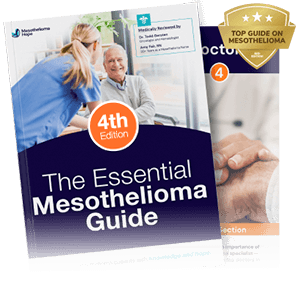Asbestos Exposure and Cancer Risk
Asbestos has been shown to increase the risk of some cancers, including mesothelioma, according to the American Cancer Society (ACS).

Asbestos is a general term for a group of minerals made up of long, stringy, and microscopic fibers. But asbestos is also a known carcinogen (cancer-causing substance).
Inhaling asbestos fibers causes the fibers to enter the body. Asbestos fibers are so strong that they cannot decompose. Over time, asbestos fibers burrow deeper into healthy tissue, causing the formation of scar tissue and, ultimately, cancerous tumors.
Different cancers can develop depending on where the fibers are lodged in the body.
Unfortunately, asbestos is still not entirely banned in the United States and can be found in millions of homes, factories, and mechanical equipment.
“Approximately half of the deaths from occupational cancer are estimated to be caused by asbestos.”
–World Health Organization (WHO)
If you or a loved one has mesothelioma or another asbestos-related cancer, we can help. Learn more with our Free Mesothelioma Guide.
Types of Cancer Caused by Asbestos
Asbestos has been linked to various types of cancer, most notably mesothelioma. In all cases of asbestos-related cancer, the greater the exposure to asbestos, the higher the individual’s risk of cancer.
Mesothelioma
Asbestos exposure is the only known cause of mesothelioma cancer. Once asbestos has triggered this cancer, it may take 10-50 years for symptoms to develop.
Registered Nurse Amy Fair discusses how exposure to asbestos can cause mesothelioma. View Transcript.
Duration: 1 min 06 sec
What are the causes of mesothelioma?
Many times after being diagnosed with mesothelioma your physician may ask you if you have been exposed to asbestos. Asbestos is a causative factor for mesothelioma. Some of the imaging studies may show underlying pleural plaques which are indicated that they have been around asbestos and may show underlying asbestosis.
The risk factors for developing mesothelioma are working around asbestos-related products or being indirectly around those products such as secondhand exposures that are seen with wives that launder their loved ones’ clothes and have asbestos dust on them. So direct asbestos exposure, as well as indirect asbestos exposure, can be causative factors for mesothelioma.
If you have symptoms of mesothelioma or any asbestos-related disease, it’s important that you inform your doctor of your asbestos exposure so that appropriate testing can be done.
Approximately 3,000 people are diagnosed with malignant mesothelioma each year in the United States.
There are 4 types of mesothelioma:
- Pleural Mesothelioma: This type of mesothelioma develops in the pleura, which is the part of the mesothelium that serves as the lining of the lungs. Approximately 80% of mesothelioma cases are pleural mesothelioma.
- Peritoneal Mesothelioma: This type of cancer attacks the abdominal lining and neighboring organs. The stomach, liver, and spleen are all targets for peritoneal mesothelioma. This type accounts for roughly 20% of mesothelioma cases.
- Pericardial Mesothelioma: With this type, asbestos fibers get lodged in the heart lining (pericardium). Often misdiagnosed as another cardiac ailment, pericardial mesothelioma is quite rare, making up about 1% of all cases.
- Testicular Mesothelioma: This is a very rare type of mesothelioma that develops in the lining of the testes (tunica vaginalis). There are less than 300 confirmed testicular mesothelioma cases recorded in medical literature.
Mesothelioma often has a poor outlook for recovery and life expectancy, but there are treatments available for all types.
Further, the companies that exposed millions of Americans to asbestos and put them at risk of this terrible disease were forced to set aside asbestos trust funds to compensate their victims.


Our team can help you find medical care and financial aid after a mesothelioma diagnosis.
Lung Cancer
Asbestos-related lung cancer is caused by inhaling or swallowing asbestos particles. Unlike pleural mesothelioma, which forms in the lung lining, asbestos lung cancer first develops within the lungs themselves.
Workers might have inhaled asbestos fibers during:
- Asbestos mining
- The breaking down of asbestos products, which disturbs the fibers and releases them into the air
- The manufacturing of asbestos-containing products
20% of tumors located in the lungs are linked to asbestos exposure.
Asbestos exposure can lead to lung cancer in a two-part process:
- Asbestos fibers embed themselves in the soft inner tissues of the lungs.
- Asbestos fibers travel over the soft tissue and make their way into the lung lining.


Once these fibers are in the lungs, there is no way for them to be forced out, so they start to create small incisions. The body’s natural reaction is to begin the healing process by trying to cover these small incisions with scar tissue.
This can create small or large buildups over time (tumors). In some instances, the tumors will become malignant, meaning they have the ability to spread. Like in cases of mesothelioma, it may take 10-50 years to develop lung cancer after asbestos exposure.
Smoking tobacco products can greatly increase a person’s risk of lung cancer tied to asbestos. Patients who smoke are up to 50 times more likely to contract asbestos-related cancer than non-smokers.
Other Cancers Linked to Asbestos
In addition to mesothelioma, asbestos can cause many other types of cancer.
Other asbestos-related cancers include:
- Cancers found in other abdominal organs
- Colorectal cancer
- Laryngeal (voice box) cancer
- Ovarian cancer
- Pharyngeal (throat) cancer
- Stomach cancer
Non-Cancerous Asbestos Diseases
Non-cancerous (benign) diseases may also result from asbestos exposure. Benign asbestos diseases are still hazardous to an individual’s health. In some cases, those with non-cancerous asbestos diseases also develop cancer.
Asbestosis
Asbestosis involves the scarring of the lung tissue due to asbestos fibers. This scarring causes discomfort, pain, and difficulty breathing.
Similar to other asbestos-related diseases, asbestosis causes the body to try to heal the scars in the lining of the lungs. This condition can lead to life-threatening health problems, such as cardiac or respiratory dysfunction and potential failure, especially over time.
Pleural Plaques
Pleural plaques are another type of non-cancerous disease associated with exposure to asbestos. These are hardened (calcified) buildups of collagen, a protein naturally produced within the body.
Pleural plaques are unique in that they cause no symptoms and are usually harmless. That said, those with pleural plaques could be at risk of other asbestos-related diseases later in life.
Pleural Effusion
Pleural effusions are buildups of liquid between layers of lung tissue and the outer layer of the lungs.
Symptoms of pleural effusions include:
- Chest pain
- Difficulty breathing
- Dry cough
Pleural effusion symptoms can be alleviated by having a doctor drain the liquid from the lungs.
Other Non-Cancerous Asbestos Diseases
- Atelectasis (collapsed lung)
- Chronic obstructive pulmonary disease (COPD)
- Diffuse pleural thickening
- Pericardial effusion (fluid buildup in heart lining)
- Peritoneal effusion (fluid buildup in abdomen lining)
Symptoms of Asbestos-Related Cancers
Symptoms of asbestos cancers vary depending on where the tumors first form. Get a breakdown of the symptoms of asbestos-related cancers below.
| Cancer | Symptoms |
|---|---|
| Pleural Mesothelioma | Difficulty breathing and swallowing, shortness of breath, fatigue, hoarseness, and pain in the chest, shoulders, upper back, and ribs |
| Peritoneal Mesothelioma | Abdominal cramping, blood in feces (stool), sharp lower torso pain, weight loss, fever, nausea, vomiting blood, bowel irregularities, pain in ribs and upper back |
| Pericardial Mesothelioma | Chest pain, difficulty breathing, dizziness, and dry mouth |
| Testicular Mesothelioma | Swelling and fluid buildup in the testicle lining |
| Lung Cancer | Cough that doesn't go away, coughing up blood (even a small amount), shortness of breath, chest pain, hoarseness, excess weight loss, bone pain, and headache |
Symptoms of asbestos-related cancers have a very long latency period — it’s often not until 10 to 50 years after someone is first exposed that symptoms appear.
Usually, by the time symptoms become severe enough to warrant alarm, the cancers have already spread to other parts of the body.
How Asbestos Cancer Is Diagnosed
Doctors typically follow a step-by-step process to diagnose asbestos cancers, from non-invasive to invasive procedures.
The diagnostic process for asbestos cancers includes:
- Imaging Scans: These are usually the first detection step. Non-invasive images look for tell-tale evidence of cancer like tumor shadows. X-rays, CT scans, MRIs, and PET scans are common mesothelioma imaging scans.
- Blood Tests and Biomarkers: Diagnostic blood tests sometimes accurately isolate cancer cells microscopically confirmed by pathologists. More often, blood indicators called biomarkers suggest mesothelioma but warrant further invasive exploration.
- Biopsies: The only way to diagnose mesothelioma and lung cancer is through a biopsy, a test that takes cell samples from a suspected cancer-infected organ. Biopsies can be conducted using needle insertion or surgery.
In particular, mesothelioma is difficult to detect unless doctors and medical teams are familiar with the disease, its range of symptoms, and whether the patient has been exposed to asbestos.
Detection usually happens when a mesothelioma patient is in a later stage and experiencing severe symptoms. However, mesothelioma is often misdiagnosed as other diseases — including other types of cancer.
Treating Asbestos Cancers


Multiple treatment options exist, depending on the type of asbestos-related disease or cancer an individual has been diagnosed with.
Notably, mesothelioma treatments vary depending on which type a patient has. The goal of these treatments is to soothe patients’ symptoms and, in some cases, prolong their life.
The most common treatments for mesothelioma include:
- Mesothelioma chemotherapy: Medicine designed to shrink or kill the cancer
- Mesothelioma radiation: High energy rays used to kill cancer
- Mesothelioma surgery: Physical removal of visible cancer tumors
Lung cancer patients also have the option of surgery, chemotherapy, or radiation therapy. Another treatment option is targeted therapy, which involves taking pills or intravenous medicines directed to a specific area to block the growth and spread of cancerous cells.
The team at Mesothelioma Hope is available to help patients connect with top doctors who have experience treating asbestos cancers.
Formation of Asbestos Cancer Cells
Asbestos causes cancer in two ways:
- Mitosis: Asbestos fibers are thought to penetrate cell walls and damage normal DNA, interrupting the cell division process (mitosis) and causing mutated cancer cells to divide.
- Mutation: Mesothelial cells react to the asbestos’ presence and release a mutagenic compound that reacts with blood oxygen and nitrogen. This reaction also causes mutated cell production or cancer.
Cancer and Types of Asbestos
There are two different classes of asbestos, according to the National Cancer Institute (NCI), and all of them can cause cancer.
The serpentine class, which only contains chrysotile asbestos, was most commonly used in manufacturing asbestos-containing materials.
Because this type was the most widely used, it accounts for the majority of cases of mesothelioma and asbestos-related cancers.
The other asbestos class is the amphibole fiber group.
Types of amphibole asbestos fibers include:
- Crocidolite
- Amosite
- Tremolite
- Actinolite
- Anthophyllite
Though amphibole asbestos fibers were less commonly used than serpentine asbestos, all types pose a threat to human health.
Further, while those who were exposed to asbestos more frequently are at a higher risk of illness, even those exposed just once could develop mesothelioma or other asbestos-related cancers later in life.
Next Steps for Asbestos Cancer Patients
Patients with any type of asbestos-related cancer should seek medical treatment from specialists. Asbestos disease specialists can work with you to find the right medical treatments to improve your quality of life and prolong your survival.
Cancer treatments can be expensive, but you may be eligible for financial compensation that can help you pay for the costs. If you have any questions about your options, contact us today.
Asbestos Cancer FAQs
What cancers are caused by asbestos?
Prolonged exposure to asbestos can cause a wide range of cancers, including:
- Mesothelioma
- Lung cancer
- Ovarian cancer
- Pharyngeal throat cancer
- Testicular cancer
How long does it take for asbestos to cause cancer?
It can take 10-50 years from a person’s first exposure to asbestos for symptoms of an asbestos-related cancer like mesothelioma to appear.
How much asbestos exposure causes cancer?
There is no such thing as a safe amount of asbestos exposure, so contact with any amount of asbestos can be harmful to your health.
How common is cancer from asbestos?
Cancer from asbestos is rare. For example, about 3,000 Americans are diagnosed with the asbestos-caused cancer mesothelioma each year.
By comparison, nearly 300,000 women in the U.S. were diagnosed with breast cancer in 2023.





